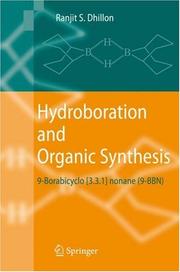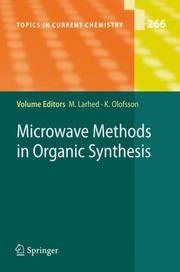| Listing 1 - 10 of 12 | << page >> |
Sort by
|

ISBN: 1280853719 9786610853717 3540490760 3540490752 3642080340 Year: 2007 Publisher: Berlin ; New York : Springer,
Abstract | Keywords | Export | Availability | Bookmark
 Loading...
Loading...Choose an application
- Reference Manager
- EndNote
- RefWorks (Direct export to RefWorks)
9-Borabicyclo [3.3.1]nonane, a commercially available reagent, is the most versatile hydroborating reagent to synthesize organoboranes (B-R-9-BBN). The reagent exhibits remarkable regio-, chemo-, and stereoselectivity during hydroboration reactions. The organoboranes can be converted to C-H, C-O, C-N, C-S, C-halogen, C-metal and above all C-C bonds. In addition, the suitable substituted / unsaturated R of B-R-9-BBN can be utilized to produce dienes, enynes, allenes etc. with defined stereochemistry. 9-BBN’s derivatives have been elegantly used for the asymmetric reduction of ketone moiety. Diels-Alder and Suzuki reactions have expanded the utility of 9-BBN for the synthesis of a variety of organic compounds required for industry. Consequently, this vast field in the form of a book will be helpful to synthetic organic chemists for easy access to literature, required for chemical transformations.
Hydroboration. --- Organic compounds --- Synthesis. --- Chemistry, Organic --- Chemistry, Synthetic organic --- Organic synthesis (Chemistry) --- Synthetic organic chemistry --- Reduction (Chemistry) --- Synthesis --- Chemistry, Organic. --- Biochemistry. --- Organic Chemistry. --- Medicinal Chemistry. --- Biochemistry, general. --- Biological chemistry --- Chemical composition of organisms --- Organisms --- Physiological chemistry --- Biology --- Chemistry --- Medical sciences --- Organic chemistry --- Composition --- Organic chemistry. --- Medicinal chemistry. --- Chemistry, Medical and pharmaceutical --- Chemistry, Pharmaceutical --- Drug chemistry --- Drugs --- Medical chemistry --- Medicinal chemistry --- Pharmacochemistry
Book
ISBN: 1281913731 9786611913731 3211751254 3211751246 Year: 2008 Publisher: Wien ; New York : Springer,
Abstract | Keywords | Export | Availability | Bookmark
 Loading...
Loading...Choose an application
- Reference Manager
- EndNote
- RefWorks (Direct export to RefWorks)
Materials syntheses are generally more complex than syntheses of inorganic or organic compounds, and specific characterization methods play a more important role. Materials synthesis protocols often suffer from unclarities, irreproducibility, lack in detail and lack in standards. The need to change this situation is the main motivation for this book. A number of detailed protocols has been collected, ranging from organic polymers to carbonaceous and ceramic materials, from gels to porous and layered materials and from powders and nanoparticles to films. Preparation methods include intercalation and flux methods, sol-gel processing, templating methods for porous materials, sonochemistry or spray pyrolysis. Each contribution provides detailed and unambiguous description of the hardware, specific characteristics of the procedure, scope of applicability as well as methods that unequivocally identify and characterize the material and allow checking whether the synthesis was successful.
Organic compounds --- Chemistry, Organic. --- Synthesis. --- Organic chemistry --- Chemistry --- Chemistry, Organic --- Chemistry, Synthetic organic --- Organic synthesis (Chemistry) --- Synthetic organic chemistry --- Synthesis --- Materials. --- Chemistry, inorganic. --- Nanotechnology. --- Materials Science, general. --- Inorganic Chemistry. --- Molecular technology --- Nanoscale technology --- High technology --- Inorganic chemistry --- Inorganic compounds --- Engineering --- Engineering materials --- Industrial materials --- Engineering design --- Manufacturing processes --- Materials --- Materials science. --- Inorganic chemistry. --- Material science --- Physical sciences

ISSN: 03401022 ISBN: 9783540728788 3540728783 9786610943715 1280943718 3540728791 Year: 2007 Volume: 279 Publisher: Berlin, Germany : Springer,
Abstract | Keywords | Export | Availability | Bookmark
 Loading...
Loading...Choose an application
- Reference Manager
- EndNote
- RefWorks (Direct export to RefWorks)
Organic compounds --- Metal catalysts. --- Composés organiques --- Catalyseurs métalliques --- Synthesis. --- Synthèse --- Metal catalysts --- Synthesis --- Organic compounds -- Synthesis. --- Organometallic Compounds --- Organic Chemicals --- Catalysis --- Chemicals and Drugs --- Chemical Processes --- Inorganic Chemicals --- Physicochemical Processes --- Physicochemical Phenomena --- Chemical Phenomena --- Phenomena and Processes --- Biochemistry --- Organic Chemistry --- Chemistry --- Physical Sciences & Mathematics --- Chemistry, Organic --- Chemistry, Synthetic organic --- Organic synthesis (Chemistry) --- Synthetic organic chemistry --- Chemistry. --- Organic chemistry. --- Organometallic chemistry. --- Organic Chemistry. --- Organometallic Chemistry. --- Catalysts --- Chemistry, Organic. --- Organic chemistry --- Organometallic chemistry . --- Chemistry, Organometallic --- Metallo-organic chemistry --- Organic compounds - Synthesis
Book
ISBN: 3540896910 3540896929 Year: 2009 Publisher: Berlin ; [London] : Springer,
Abstract | Keywords | Export | Availability | Bookmark
 Loading...
Loading...Choose an application
- Reference Manager
- EndNote
- RefWorks (Direct export to RefWorks)
Organic Chemicals --- Models, Molecular --- Molecular Structure --- Physicochemical Phenomena --- Chemicals and Drugs --- Models, Theoretical --- Biochemical Phenomena --- Chemical Phenomena --- Phenomena and Processes --- Investigative Techniques --- Analytical, Diagnostic and Therapeutic Techniques and Equipment --- Biochemistry --- Chemistry --- Physical Sciences & Mathematics --- Chemical templates. --- Fullerenes. --- Organic compounds --- Synthesis. --- Chemistry, Organic --- Chemistry, Synthetic organic --- Organic synthesis (Chemistry) --- Synthetic organic chemistry --- Molecular templates --- Templates (Chemistry) --- Synthesis --- Chemistry. --- Inorganic chemistry. --- Organic chemistry. --- Organic Chemistry. --- Inorganic Chemistry. --- Carbon --- Molecules --- Chemistry, Organic. --- Chemistry, inorganic. --- Inorganic chemistry --- Inorganic compounds --- Organic chemistry
Book
ISBN: 3540792198 3540792201 Year: 2009 Publisher: Berlin, Heidelberg : Springer Berlin Heidelberg : Imprint: Springer,
Abstract | Keywords | Export | Availability | Bookmark
 Loading...
Loading...Choose an application
- Reference Manager
- EndNote
- RefWorks (Direct export to RefWorks)
Synthesis is at the core of organic chemistry. In order for compounds to be studied—be it as drugs, materials, or because of their physical properties— they have to be prepared, often in multistep synthetic sequences. Thus, the target compound is at the outset of synthesis planning. Synthesis involves creating the target compound from smaller, readily available building blocks. Immediately, questions arise: From which bui- ing blocks? In which sequence? By which reactions? Nature creates many highly complex “natural products” via reaction cascades, in which an asso- ment of starting compounds present within the cell is transformed by speci c (for each target structure) combinations of modular enzymes in speci c - quences into the target compounds [1, 2]. To mimic this ef ciency is the dream of an ideal synthesis [2]. However, we are at present so far from - alising such a “one-pot” operation that actual synthesis has to be achieved via a sequence of individual discrete steps. Thus, we are left with the task of planning each synthesis individually in an optimal fashion. Synthesis planning must be conducted with regard for certain speci - tions, some of which are due to the structure of the target molecule, and some of which relate to external parameters such as costs, environmental compatibility, or novelty. We will not consider these external aspects in this context. Planning of a synthesis is based on a pool of information regarding chemical reactions that can be executed reliably and in high chemical yield.
Chemistry, Organic. --- Electronic books. -- local. --- Organic compounds -- Synthesis. --- Chemical reactions --- Inorganic compounds --- Organic compounds --- Biochemistry --- Organic Chemistry --- Chemistry --- Physical Sciences & Mathematics --- Planning --- Synthesis --- Synthesis. --- Chemistry, Organic --- Chemistry, Synthetic organic --- Organic synthesis (Chemistry) --- Synthetic organic chemistry --- Organic chemistry --- Chemistry. --- Organic chemistry. --- Medicinal chemistry. --- Biochemistry. --- Organic Chemistry. --- Medicinal Chemistry. --- Biochemistry, general. --- Biological chemistry --- Chemical composition of organisms --- Organisms --- Physiological chemistry --- Biology --- Medical sciences --- Composition --- Planning. --- Chemistry, Medical and pharmaceutical --- Chemistry, Pharmaceutical --- Drug chemistry --- Drugs --- Medical chemistry --- Medicinal chemistry --- Pharmacochemistry
Book
ISBN: 3642028144 9786613560728 3642028152 1280382813 9783642028144 Year: 2010 Publisher: Berlin ; Heidelberg : Springer-Verlag,
Abstract | Keywords | Export | Availability | Bookmark
 Loading...
Loading...Choose an application
- Reference Manager
- EndNote
- RefWorks (Direct export to RefWorks)
Asymmetric synthesis --- Catalysis --- Organic compounds --- Physicochemical Processes --- Chemical Processes --- Chemicals and Drugs --- Amines --- Organic Chemicals --- Physicochemical Phenomena --- Chemical Phenomena --- Phenomena and Processes --- Chemistry --- Organic Chemistry --- Physical Sciences & Mathematics --- Synthesis --- Asymmetric synthesis. --- Catalysis. --- Synthesis. --- Chemistry, Synthetic organic --- Organic synthesis (Chemistry) --- Synthetic organic chemistry --- Asymmetric induction --- Induction, Asymmetric --- Synthesis, Asymmetric --- Chemistry. --- Organometallic chemistry. --- Organometallic Chemistry. --- Activation (Chemistry) --- Chemistry, Physical and theoretical --- Surface chemistry --- Chemistry, Organic --- Asymmetry (Chemistry) --- Chemistry, Organic. --- Organic chemistry --- Organometallic chemistry . --- Chemistry, Organometallic --- Metallo-organic chemistry --- Organic compounds - Synthesis

ISSN: 03401022 ISBN: 9783540230878 3540230874 3540314717 Year: 2005 Volume: 249 Publisher: Berlin, Heidelberg : Springer Berlin Heidelberg : Imprint: Springer,
Abstract | Keywords | Export | Availability | Bookmark
 Loading...
Loading...Choose an application
- Reference Manager
- EndNote
- RefWorks (Direct export to RefWorks)
Organic Chemicals --- Models, Molecular. --- Molecular Structure. --- Organic compounds --- Chemical templates. --- Composés organiques --- chemical synthesis. --- Synthesis. --- Synthèse --- Chemistry. --- Chemistry, inorganic. --- Chemistry, Organic. --- Polymers. --- Condensed matter. --- Organic Chemistry. --- Inorganic Chemistry. --- Condensed Matter. --- Polymer Sciences. --- Chemistry --- Physical Sciences & Mathematics --- Biochemistry --- Condensed materials --- Condensed media --- Condensed phase --- Materials, Condensed --- Media, Condensed --- Phase, Condensed --- Polymere --- Polymeride --- Polymers and polymerization --- Organic chemistry --- Inorganic chemistry --- Inorganic chemistry. --- Organic chemistry. --- Condensed Matter Physics. --- Chemical templates --- Chemistry, Organic --- Chemistry, Synthetic organic --- Organic synthesis (Chemistry) --- Synthetic organic chemistry --- Molecular templates --- Templates (Chemistry) --- Molecules --- Synthesis --- Macromolecules --- Inorganic compounds --- Polymers . --- Liquids --- Matter --- Solids --- Organic compounds - Synthesis. --- Organic Chemicals - chemical synthesis.

ISSN: 03401022 ISBN: 9783540367574 3540367578 9786610717057 128071705X 3540367594 Year: 2006 Volume: 266 Publisher: Berlin, Heidelberg : Springer,
Abstract | Keywords | Export | Availability | Bookmark
 Loading...
Loading...Choose an application
- Reference Manager
- EndNote
- RefWorks (Direct export to RefWorks)
Organic compounds --- Microwaves. --- Composés organiques --- Micro-ondes --- Synthesis. --- Synthèse --- Microwaves --- Synthesis --- Electronic books. -- local. --- Organic compounds -- Synthesis. --- Organic Chemicals --- Chemistry, Organic --- Chemistry --- Radio Waves --- Chemicals and Drugs --- Natural Science Disciplines --- Radiation, Nonionizing --- Radiation --- Disciplines and Occupations --- Electromagnetic Phenomena --- Physical Phenomena --- Phenomena and Processes --- Chemistry - General --- Biochemistry --- Physical Sciences & Mathematics --- Hertzian waves --- Chemistry, Synthetic organic --- Organic synthesis (Chemistry) --- Synthetic organic chemistry --- Chemistry. --- Organic chemistry. --- Physical chemistry. --- Organic Chemistry. --- Physical Chemistry. --- Electric waves --- Electromagnetic waves --- Geomagnetic micropulsations --- Radio waves --- Shortwave radio --- Chemistry, Organic. --- Chemistry, Physical organic. --- Chemistry, Physical organic --- Chemistry, Physical and theoretical --- Organic chemistry --- Chemistry, Theoretical --- Physical chemistry --- Theoretical chemistry --- Organic compounds - Synthesis
Periodical
Abstract | Keywords | Export | Availability | Bookmark
 Loading...
Loading...Choose an application
- Reference Manager
- EndNote
- RefWorks (Direct export to RefWorks)
Organic Chemicals --- Organometallic Compounds --- Heterocyclic Compounds --- Organic compounds --- Organometallic compounds --- Heterocyclic compounds --- Composés organiques --- Composés organométalliques --- Composés hétérocycliques --- Periodicals --- Périodiques --- Organometallic chemistry --- Heterocyclic chemistry --- Organic Chemicals. --- Organometallic Compounds. --- Heterocyclic Compounds. --- Heterocyclic chemistry. --- Organometallic chemistry. --- Synthesis --- Synthesis. --- Chemistry, Organometallic --- Metallo-organic chemistry --- Chemistry, Organic --- Chemistry, Synthetic organic --- Organic synthesis (Chemistry) --- Synthetic organic chemistry --- Heteroatomic chemistry --- Compounds, Heterocyclic --- Metalloorganic Compounds --- Metallo-Organic Compounds --- Compounds, Metallo-Organic --- Compounds, Metalloorganic --- Compounds, Organometallic --- Metallo Organic Compounds --- Chemicals, Organic --- Polycyclic Compounds --- Metals --- Organic Chemistry --- Heterocyclic Compound --- Compound, Heterocyclic --- Metallo-Organic Compound --- Metalloorganic Compound --- Organometallic Compound --- Compound, Metallo-Organic --- Compound, Metalloorganic --- Compound, Organometallic --- Metallo Organic Compound --- Organic Chemical --- Chemical, Organic

ISBN: 1280901896 9786610901890 1402042965 1402042949 9401785074 Year: 2006 Publisher: Dordrecht : Springer,
Abstract | Keywords | Export | Availability | Bookmark
 Loading...
Loading...Choose an application
- Reference Manager
- EndNote
- RefWorks (Direct export to RefWorks)
Heterogeneous Enantioselective Hydrogenation: Theory and Practice reviews the development of enantioselective hydrogenation reaction catalysts. The book looks at the first relatively ineffective catalysts right through to modern highly effective enantioselective catalytic systems, comparable in their efficiency to chiral metal complexes and enzymatic systems. The book begins with a summary of the first work on heterogeneous metal catalysts, which showed only the principal possibilities of enantioselective reactions. The book then elaborates on metal catalysts which have enantioselectivities close to 100%. Finally, the book describes the practical utilization of chiral catalytic systems in processes of hydrogenation. The a - and b -hydroxy carboxylic acid esters produced are precursors for manufacturing many synthones used for medicines as well as for monomers used for biodegradable polyesters, both of which have important practical applications. The book summarizes more than 800 scientific papers in the field of enantioselective catalytic hydrogenation reactions, mainly those using heterogeneous metal catalysts. It provides detailed explanations of special techniques for the preparation of effective dissymmetric catalysts which provide highly efficient catalytic systems. This book differs from previous publications by virtue of the recommendations for the practical utilization of recently described preparations of metal catalysts. Heterogeneous Enantioselective Hydrogenation: Theory and Practice will be an invaluable resource to catalysis researchers as well as to those utilizing the technology.
Hydrogenation. --- Catalysis. --- Metal catalysts. --- Organic compounds --- Synthesis. --- Activation (Chemistry) --- Chemistry, Physical and theoretical --- Surface chemistry --- Catalysts --- Chemistry, Organic --- Chemistry, Synthetic organic --- Organic synthesis (Chemistry) --- Synthetic organic chemistry --- Synthesis --- Chemistry, Organic. --- Surfaces (Physics). --- Chemical engineering. --- Evolution (Biology). --- Organic Chemistry. --- Organometallic Chemistry. --- Surfaces and Interfaces, Thin Films. --- Industrial Chemistry/Chemical Engineering. --- Evolutionary Biology. --- Animal evolution --- Animals --- Biological evolution --- Darwinism --- Evolutionary biology --- Evolutionary science --- Origin of species --- Biology --- Evolution --- Biological fitness --- Homoplasy --- Natural selection --- Phylogeny --- Chemistry, Industrial --- Engineering, Chemical --- Industrial chemistry --- Engineering --- Chemistry, Technical --- Metallurgy --- Physics --- Surfaces (Technology) --- Organic chemistry --- Chemistry --- Organic chemistry. --- Organometallic chemistry . --- Materials—Surfaces. --- Thin films. --- Evolutionary biology. --- Films, Thin --- Solid film --- Solid state electronics --- Solids --- Coatings --- Thick films --- Chemistry, Organometallic --- Metallo-organic chemistry
| Listing 1 - 10 of 12 | << page >> |
Sort by
|

 Search
Search Feedback
Feedback About UniCat
About UniCat  Help
Help News
News